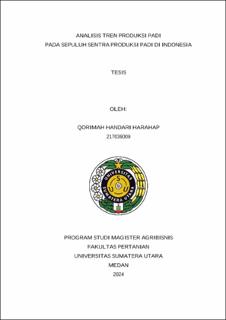Analisis Tren Produksi Padi pada Sepuluh Sentra Produksi Padi di Indonesia
| dc.contributor.advisor | Lubis, Zulkifli | |
| dc.contributor.advisor | Supriana, Tavi | |
| dc.contributor.author | Harahap, Qorimah Handari | |
| dc.date.accessioned | 2025-01-13T07:47:20Z | |
| dc.date.available | 2025-01-13T07:47:20Z | |
| dc.date.issued | 2024 | |
| dc.identifier.uri | https://repositori.usu.ac.id/handle/123456789/100074 | |
| dc.description.abstract | Rice production holds a strategic role in fulfilling food and economic needs in Indonesia, given that rice is the staple food for the majority of the population. This study analyzes the trends in rice production across the ten largest provinces in Indonesia over the period 2009-2023, and identifies the most effective forecasting model for predicting future rice production. The quadratic model has been identified as the most suitable forecasting model for the majority of the provinces, as evidenced by high R-squared values, such as in West Java (80.09%), North Sumatra (75.30%), and Aceh (72.90%). However, this model shows limitations in some provinces like Lampung and Banten, with R-squared values of 32.40% and 37.40%, respectively. The production forecasts for 2024 indicate a decline in production in most provinces, with some exhibiting a more stable decline. | en_US |
| dc.language.iso | id | en_US |
| dc.publisher | Universitas Sumatera Utara | en_US |
| dc.subject | Rice Production | en_US |
| dc.subject | Forecasting | en_US |
| dc.subject | Quadratic Model | en_US |
| dc.subject | Food Security | en_US |
| dc.subject | Production Trends | en_US |
| dc.title | Analisis Tren Produksi Padi pada Sepuluh Sentra Produksi Padi di Indonesia | en_US |
| dc.title.alternative | Analysis of Rice Production Trends in Ten Major Rice-Producing Centers in Indonesia | en_US |
| dc.type | Thesis | en_US |
| dc.identifier.nim | NIM217039009 | |
| dc.identifier.nidn | NIDN8847040017 | |
| dc.identifier.nidn | NIDN0002116403 | |
| dc.identifier.kodeprodi | KODEPRODI54101#Agribisnis | |
| dc.description.pages | 65 Pages | en_US |
| dc.description.type | Tesis Magister | en_US |
| dc.subject.sdgs | SDGs 2. Zero Hunger | en_US |
Files in this item
This item appears in the following Collection(s)
-
Master Theses [287]
Tesis Magister


